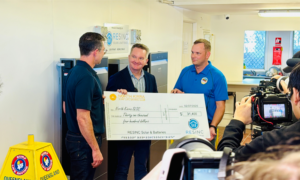A simple cup of coffee inspired a research breakthrough that could see perovskite solar cells replace silicon ones.
Graduate student Rui Wang from UCLA was drinking coffee with colleagues in March last year. Wang decided to test whether caffeine’s chemical structure could solve perovskite’s key problem – its inability to cope with harsh sunlight.
His experiment worked. As a result, it takes perovskite solar cells closer to being commercially viable. It also opens the door to research of other materials which – like caffeine – can unlock the true potential of perovskite solar.
Perovskite solar: Researchers wake up to real potential
Perovskite solar cells are now regarded as the future of solar energy technology. That’s because they have the potential to be more cost-effective and energy-efficient than silicon.

Perovskite is a mineral, but its name also refers to materials that shares its crystalline structure. In fact, cheap, readily available elements like lead and iodine can make perovskite-like structures. Perovskite cells are therefore cheaper and easier to make than silicon cells, the problem is their instability.
Research really kicked off in 2010, taking perovskite technology close to rivalling silicon in terms of cost and performance.
Perovskite materials’ structure makes solar cells highly effective at converting light into electricity. Until now, however, it has been quickly broken down by direct and constant sunlight – significantly reducing performance in solar panels.
The experiment: Caffeine perks up perovskite stability
UCLA Professor of Engineering Yang Yang led the caffeine-based research. He says perovskite solar cells are now a step closer to lasting 20 or 30 years like traditional solar cells.
The research team added caffeine to a liquid solution of dimethylformamide, methylammonium iodide and lead iodide. They then created a glass film and built it into a solar cell.
When heated to 85°C, researchers found the device kept its thermal stability for close to 55 days. It also retained 86 per cent of the energy it took in.
A similar cell without caffeine retained only 60 per cent of its power conversion efficiency after 175 hours.
Further research needed for perovskite mass production
According to Yang, caffeine is just the start. Similar materials can now be studied to help push perovskite solar cells into commercial production.
There may be other compounds which work even more efficiently, he says.
NSW company GreatCell Solar is currently working on the manufacture of Australia’s first commercially produced perovskite solar cells.












































